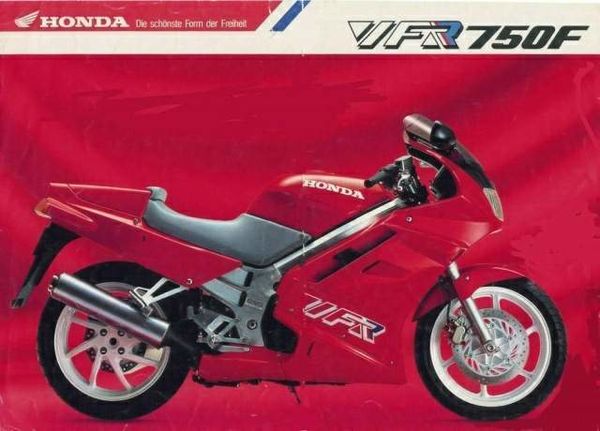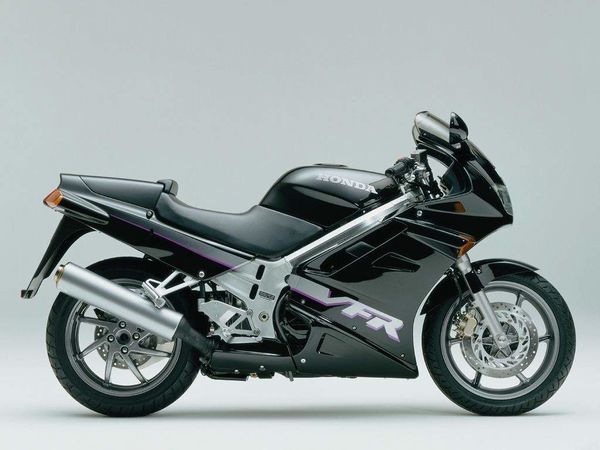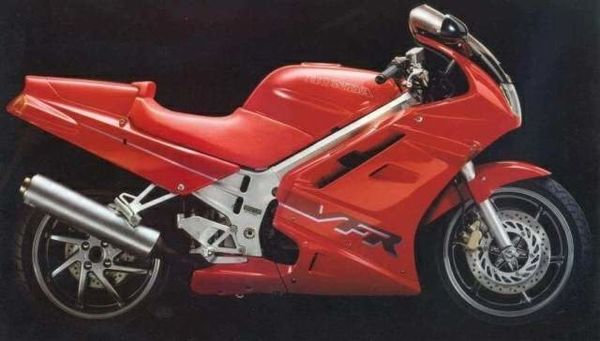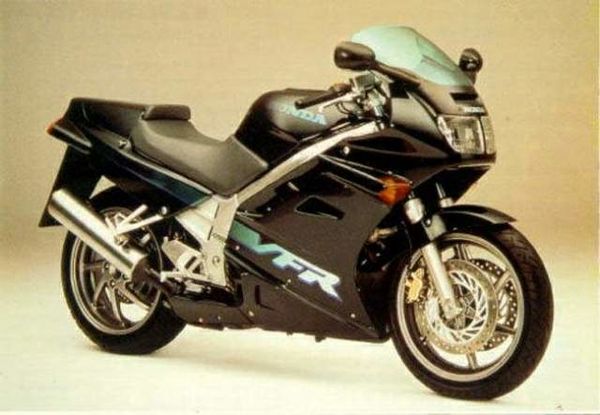Honda VFR 750F-N
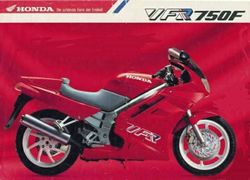 |
|
| Honda VFR 750F-N | |
| Manufacturer | |
|---|---|
| Production | 1992 |
| Class | Power Cruiser |
| Engine | Four stroke, 90°V-four cylinder, DOHC, 4 valve per cylinder |
| Compression ratio | 11.0:1 |
| Top Speed | 239.4 km/h /148.8 mph |
| Ignition | Digitalized full transistor ignition |
| Spark Plug | NGK CR8EH9 or ND U24FER9 |
| Transmission | 6 Speed constant mesh |
| Frame | Twin-spar aluminum diamond |
| Suspension | Front: 41mm Showa cartridge forks, no external adjustment Rear: Pro-link single sided swingarm, adjustable preload |
| Brakes | Front: 2x 296mm discs, 2 piston calipers Rear: Single 256mm disc,1 piston caliper |
| Front Tire | 120/70 VR17 |
| Rear Tire | 170/60 VR17 |
| Wheelbase | 1470 mm / 57.9 in |
| Weight | 216 kg / 476 lbs (dry), 236 kg / 520 lbs (wet) |
| Recommended Oil | Honda GN4 10W-40 |
| Fuel Capacity | 19 Liters / 5.0 gal |
| Manuals | Service Manual |
It could reach a top speed of 239.4 km/h /148.8 mph.
Engine[edit | edit source]
The engine was a Liquid cooled cooled Four stroke, 90°V-four cylinder, DOHC, 4 valve per cylinder. The engine featured a 11.0:1 compression ratio.
Drive[edit | edit source]
Power was moderated via the Wet, multiple discs, cable operated.
Chassis[edit | edit source]
It came with a 120/70 VR17 front tire and a 170/60 VR17 rear tire. Stopping was achieved via 2x 296mm discs, 2 piston calipers in the front and a Single 256mm disc,1 piston caliper in the rear. The front suspension was a 41mm Showa cartridge forks, no external adjustment while the rear was equipped with a Pro-link single sided swingarm, adjustable preload. The VFR 750F-N was fitted with a 19 Liters / 5.0 gal fuel tank. The bike weighed just 216 kg / 476 lbs. The wheelbase was 1470 mm / 57.9 in long.
Photos[edit | edit source]
Overview[edit | edit source]
Honda VFR 750F-N
Success at last! Considering the troubled early days of Hondo's V4 philosophy, it's a tribute to the company's perseverance that they kept at it until they got it right (but no longer white...). The result is the VFR750, always a favourite and now radically restyled to see it into the '90s. ROBERT McCABE rekindles an old friendship. here's something I want to say to you about Honda's decision to drop the white color option on the 1992 VFR750. It stinks. The deliberately understated VFR has never been one of the most outstanding lookers - yet the white paint job completely transformed it into a class act, as pleasing on the eye as it was to ride. There is no argument about the bike's classic status whatever the color, but the gorgeous, pearly white only served to accentuate the fact. And they dropped it. Honda aren't the only ones to have perpetrated murder most foul; the history of Japanese motor cycling is peppered with similar heinous crimes (coincidentally, though, the previous most serious offence also concerns a white bike. Do you remember the GPX750 Kawasaki from the mid 1980s? The beautiful white and gold one was, to my mind, just about the best-looking Japanese bike of its time. And they dropped it). So there you have it. And - honestly - not bitching because it is now so patently obvious our test machine is a 1991 model. Apart from the color scheme (you can choose from red, green or a rather drab blue), there's no difference between them and the '92 bike. There are still 1991 bikes available in the showrooms, though, and if I were the market for a new VFR I'd strike now while the iron is still (white) hot, and save my £100 into the bargain. The 1992 model, the N, is the fifth version, although many of the differences between them have been slight indeed. The first, launched in 1985 and released on an expectant UK public the following year, had a 16-inch front wheel, four-into-two exhaust system, conventional swinging arm suspension and an easy- to-use (although plug ugly) giant fuel tap like something from a washing machine built in to the side of the petrol tank. It had a fuller, less streamlined fairing than the current one. The next one up, the VFR750 H of 1987, featured only minor revisions and - new colors aside - was probably most easily identified by glancing at the instrument panel, wherein lived the new clock. And that was about it. In 1988, the arrival of 17-inch wheels and some subtle reworking of the fairing was your lot, continuing the modest changes that confirmed there wasn't much needing attention on a bike that was obviously so well-sorted from the word go. But in 1990, the changes took an altogether more radical (by VFR standards, anyway) turn. The fairing was completely redesigned to make it somewhat sharper and meaner, and wider wheels were fitted to take advantage of the massive improvements in tire technology that has been made in the five years since its launch. A bendy single sided swinger and tasty 4 into 1 completed its transformation into something of an RC29 and a half in appearance. And the engine was retuned to give more mid-range urge. I remember with affection my time with the original VFR shortly after its arrival in 1986, an in particular one memorable run from South London, through Newcastle and through Edinburgh to the Forth Bridge. Including petrol stops, my carefully calculated average speed topped 70mph. It was a tribute to the lovely, lolloping, power delivery that poured out, nectar-like, at every turn of the throttle, not to mention a surprising lack of contra-flows on the A1. So I expected lots from this latest one. For the most part I wasn't disappointed, although there were one or two question marks I was surprised to encounter on a bike as expensive as this. A happy bear was I on pulling away for the first time, that lovely lolloling power delivery was still there, and it feels wonderful, it really does. Not for this bike the buzzy, high frequency vibes experienced to a greater of lesser degree on most across the frame fours.
Despite the internal mods to give improved midrange power,
the VFR still likes lots of revs and not an awful lot of any note happens below
7000rpm. Snapping the throttle open from 4500rpm in top (50mph) results in a
slight lag before a clean take-up, but it still feels brilliantly smooth all the
while. The rev limiter cuts in at 12,500rpm or thereabouts, but power has notice
ably started to tail off by then in any case, so there's re ally no need to
inflict unnecessary suffering on the engine.
So smooth is it, in fact, it always feels relaxed - even if it is actually revving quite hard. Cruising at 8Omph, for example, offers hardly any sensation of speed. Much of the credit for this has to go to the fairing, whose low-slung profile would have you believe its primary function was a cosmetic one. Appearances can be deceptive though, and in this case they are downright bloody liars. The bodywork provides outstanding wind cheating protection for hands, knees, feet and torso, allowing long distances to be covered at high speed in superb comfort. The build quality of the whole bike is exemplary, but the chunky, well-finished fairing is what most stands out in this regard. It's pleasing that Honda have resisted the temptation to cut corners in order to produce a machine that might have cost a few bob less, but would lack the refinement that has become the VFR's trademark.
The cycle parts earn mixed reviews. The banana rear end is superb, and copes with everything you ask it to do in its stride. Things aren't so hot at the front, though. The twin-piston-caliper brakes are adequate, but I'd like something fiercer to be able to rely on, bearing in mind the rapid speeds the VFR is capable of. It's not that they don't work, but a big handful of lever is needed to do the business - and there's a considerable amount of fork dive, too. Stronger fork springs, maybe? Another hindrance to point & squirt riding is the awful gear change, although the VFR owners I have spoken to don't seem to suffer from it and so I'm willing to concede it was the (still fairly new) test bike at fault. I certainly don't remember the problem occurring on the last one I rode. When trying to change down several gears at once -a late charge into a round-about or an emergency stop, for example - it would sometimes stick in a false neutral and stay there. The advantages to be gained from going into a roundabout minus any gears have yet to be pointed out to me. And when the gearbox did eventually engage, it was anybody's guess which of the six cogs it would choose, once or twice leading to embarrassing stalls as I attempted to pull away from a virtual standstill in, say, fourth. Honda boxes are never going to win the Lurpak "Hot Knife Through Butter" Award, but this one was particularly infuriating. However, it's easy to forgive the VFR its shortcomings when it's allowed to do what it does best - eating up the miles on good, fast roads, flicking easily through the bends and cocooning its rider behind that superb, slippery fairing. An unflustered 100mph crops up at 7500rpm, and it will happily maintain that all day, road conditions and legal restrictions permitting. Night riding on unfamiliar roads is almost a pleasure, thanks to the razor-sharp main beam (something of a Honda trademark).
On long motorway runs, petrol stops are required every hour-and-a-half or so, due to a typical full-to-reserve range of just 135 miles. What is it with bike petrol tanks these days. The water-cooled motor runs continually cool; that temperature gauge needle just will not budge from its modest operating position, even when battling through the worst of London traffic for an hour or so. The light, flickable steering make it quite a good town bike, too, and you do occasionally see dispatchers on them (mind you, you see dispatchers on big Guzzis as well so - maybe we shouldn't go into that too much.) Unlike the race-replica sport 750's, it's possible to carry a passenger in reasonable comfort. A sudden urge to go out for a two up blast is made a bit less sudden by the need to take off the seat hump, remove the seat and unscrew the fold-away grab handles from their resting place, then re tighten them in position and put the seat back on. To my mind all this is a price worth paying, though, because the bike does look very pretty with the seat hump in place, with everything all neat and uncluttered up back (which is presumably why so many bikes are unforgivably not fitted with any thing for a passenger to cling on to). And the grab handles are not just an after thought; they are substantial and worthwhile. It's a clever idea, and one that works well. I was impressed by Honda's thoughtfulness in forging the size of spanner required on to the securing bolts - what a pity they got it wrong. Still, what's 2mm between friends.
| Make Model | Honda VFR 750F-N |
|---|---|
| Year | 1992 |
| Engine Type | Four stroke, 90°V-four cylinder, DOHC, 4 valve per cylinder |
| Displacement | 748 cc / 45.6 cub in |
| Bore X Stroke | 70 x 48.6 mm |
| Cooling System | Liquid cooled |
| Compression | 11.0:1 |
| Lubrication | Forced pressure and wet sump |
| Induction | 4x 36 mm Keihin CV |
| Ignition | Digitalized full transistor ignition |
| Spark Plug | NGK CR8EH9 or ND U24FER9 |
| Starting | Electric |
| Max Power | 74 kW / 102 hp @ 9500 rpm |
| Max Power Rear Tire | 65.7 kW / 88.2 hp @ 9800 rpm) |
| Max Torque | 76.5 Nm / 7.8 kgf-m / 56.4 lb-ft @ 8500 rpm |
| Clutch | Wet, multiple discs, cable operated |
| Transmission | 6 Speed constant mesh |
| Final Drive | Chain |
| Primary Reduction | 1.939 (64/33) |
| Final Reduction | (sprockets) 2.6875 (43/16) |
| Gear Ratio | 1st 2.8461 (37/13) 2nd 2.0625 (33/16) 3rd 1.6315 (31/19) 4th 1.3333 (28/21) 5th 1.1538 (30/26) 6th 1.0357 (29/28):1 |
| Frame | Twin-spar aluminum diamond |
| Front Suspension | 41mm Showa cartridge forks, no external adjustment |
| Front Wheel Travel | 140 mm / 5.5 in |
| Rear Suspension | Pro-link single sided swingarm, adjustable preload |
| Rear Wheel Travel | 130 mm / 5.2 in |
| Front Brakes | 2x 296mm discs, 2 piston calipers |
| Rear Brakes | Single 256mm disc,1 piston caliper |
| Front Wheel | 17 x 3.5 in |
| Rear Wheel | 17 x 3.5 in |
| Front Tire | 120/70 VR17 |
| Rear Tire | 170/60 VR17 |
| Rake | 26° |
| Trail | 100 mm / 3.9 in |
| Dimensions | Length 2180 mm / 85.8 in Width 700 mm / 27.6 in Height 1185 mm / 46.7 in |
| Wheelbase | 1470 mm / 57.9 in |
| Ground Clearance | 130 mm / 5.1 in |
| Dry Weight | 216 kg / 476 lbs |
| Wet Weight | 236 kg / 520 lbs |
| Fuel Capacity | 19 Liters / 5.0 gal |
| Reserve | 3.5 Liters / 0.92 gal |
| Consumption Average | 6.7 L/100/km / 15.0 km/l / 35.2 mpg |
| Braking 60 Km/h / 37 Mph - 0 | 13.6 m / 44.6 ft |
| Braking 100 Km/h / 62 Mph - 0 | 36.9 m / 121 ft |
| Standing ¼ Mile | 11.2 sec / 193.7 km/h / 120.4 mph |
| Top Speed | 239.4 km/h /148.8 mph |
| Reviews | HONDA VFR INTERCEPTOR HISTORY / VFR INFO |
